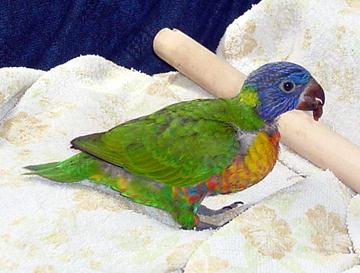All about the rainbow lorikeet:
Nutrition- For rainbows, it's a piece of cake!
Rainbow lorikeets primarily feed on pollen and nectar, although occasionally you will see them feeding on seeds, insects, flowers, non-woody fruits, corn, and a tall cereal grass called sorghum. This technically makes rainbows omnivores, but because of the fact that they are seen eating insects once in a great while, many view them as herbivores. The rainbow lorikeet gets its food with the help of its tongue, which has bristle-like papillae on it. When feeding, the tongue extends outward, and in a mop-like fashion, soaks in the pollen and nectar. The pollen that the rainbows take in provides them with protein, and the nectar provides them with carbohydrates, which are their main form of energy. Any excess nectar is then stored as body fat. The picture below shows a two-month old rainbow lorikeet chewing.
Like other chordates, a rainbow lorikeet's digestive system is very intricate, and there are regions that specialize in the breaking down of food and the transfer of nutrients. The digestive tract is where digestion takes place. The digestive tract includes the mouth, esophagus, stomach, small intestine, large intestine, rectum, and anus. The salivary glands, liver, gallbladder, and pancreas are accessory organs, which aren’t technically part of the digestive tract. They donate enzymes and other products which aid in digestion.
The rainbow lorikeet has a closed circulatory system, which means that the blood stays in the blood vessels at all times. This allows for gases and nutrients to be able to get out to the peripheral tissues faster. A rainbow has a four-chamber heart and a two-circuit circulatory system. The first circuit is the pulmonary circuit, in which the deoxygenated blood travels to the lungs, gets oxygen, and returns back to the heart. The second circuit is the systemic circuit, in which the oxygenated blood travels to all of the tissues.
Click here to learn about the life cycle and reproduction of rainbow lorikeets.
